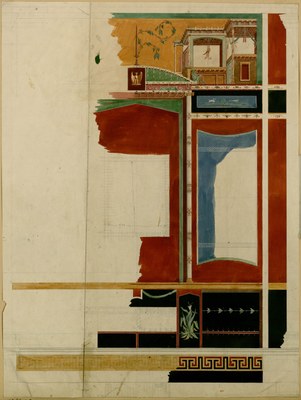Bénédicte Gady // The Pompeaian House of Prince Napoléon
The "Pompeian House" built by Prince Jérôme Napoléon, son of Jerome Bonaparte and Katharina von Württemberg, and first cousin of Napoleon III, in Paris in 1856-1860 and destroyed in 1891 was a modernized reinvention of the villa of Diomedes in Pompeii. The house was intended to be a total work of art, in the style that was then called « néogrec », or Greek Revival, although it was mainly inspired by Roman antiquity. A few steps from the Champs-Elysées, it was adjoined by a neo-Gothic house, followed by a neo-Moorish villa. The project was first entrusted to Jakob Ignaz Hittorf, who provided drawings (29 of them are now preserved in the Wallraf-Richartz Museum), which were partially used by the young architect who succeeded him, Alfred Normand. Normand has just returned from a long trip to Italy and Greece, during which he had made numerous drawings (mainly in the Musée des Beaux-Arts in Nantes). Normand reinterpreted these and added his own inventions to submit a project to Prince Napoleon that included architecture, interior design, furniture and the display of works of art. The Musée des Arts décoratifs preserves 454 preparatory drawings by the architect Alfred Normand and his agency and two photographic albums of the Villa.
The house was intended to be a total work of art, in the style that was then called « néogrec », or Greek Revival, although it was mainly inspired by Roman antiquity. A few steps from the Champs-Elysées, it was adjoined by a neo-Gothic house, followed by a neo-Moorish villa. The project was first entrusted to Jakob Ignaz Hittorf, who provided drawings (29 of them are now preserved in the Wallraf-Richartz Museum), which were partially used by the young architect who succeeded him, Alfred Normand. Normand has just returned from a long trip to Italy and Greece, during which he had made numerous drawings (mainly in the Musée des Beaux-Arts in Nantes). Normand reinterpreted these and added his own inventions to submit a project to Prince Napoleon that included architecture, interior design, furniture and the display of works of art. The Musée des Arts décoratifs preserves 454 preparatory drawings by the architect Alfred Normand and his agency and two photographic albums of the Villa.
The « Maison Pompéienne » was the subject of a monographic exhibition at the museum in 1979, accompanied by a brief 24-page catalog. Since then, only a few very fine drawings have been loaned to exhibitions but the complete study of the collection remains to be done. It implies identifying antique sources and analysing their interpretation; studying the articulation of antique models and modern requirements for comfort (heating, library); contextualizing this fascination for the antique across Europe and America, by highlighting the similarities as well as the different logics at work.
[Caption: Alfred Normand, Projet pour le vestibule de la Maison Pompéienne, vers 1856, Paris, musée des Arts décoratifs, inv. CD 2801c. Photo : Les Arts Décoratifs]
